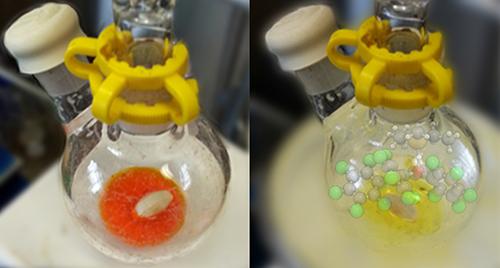Snapshots of chemical reactions: Characterizing an important reactive intermediate

Formation of the reactive borane-silane adduct at -80 Celsius is indicated by a color change. Credit: © Adrian Houghton. Artistic impression of the adduct © Akseli Mansikkamäki
Chemical reactions rarely go from starting materials to final products in one single step, but instead they progress through a number of intermediates. In many cases the intermediates are not stable enough to be studied by conventional characterization methods, which thwarts efforts to understand reaction mechanisms.
In the present case, the research group of Dr. Piers was able to undertake a comprehensive solution and solid-state characterization of an adduct between a Lewis acidic perfluoroarylborane and an electron-rich silane that has been postulated to be an intermediate in the 'frustrated' Lewis-pair hydrosilylation of C=C, C=O and C=N double bonds.
“The results of this paper are important because we now know more about the mechanistic details of a significant chemical reaction,” says Dr. Piers, a Tier I Canada Research Chair at the University of Calgary. “It is like travelling along the trans-Canada highway from Victoria to St. John's always blindfolded and finally being able to see the Rockies along the way: a breathtaking moment,” he explains.
However, characterizing an important reaction intermediate is only half of the story. Equally important is to understand what factors contribute to its stability and by how much. Here the research group of Academy Research Fellow Dr. Tuononen comes into play with the tools of theoretical modelling.
“Computational work showed that this is a good example of the Goldilocks effect in chemistry: everything needs to be 'just right',” tells Dr. Tuononen. “The calculations not only pinpoint the important contributors to the stability but also enable us to use this information to design similar adducts that are even more stable. This way we can study them experimentally in greater detail for further insight into the underlying chemistry.”
“Direct observation of a borane–silane complex involved in frustrated Lewis-pair-mediated hydrosilylations” by Adrian Y. Houghton, Juha Hurmalainen, Akseli Mansikkamäki, Warren E. Piers and Heikki M. Tuononen was published online in Nature Chemistry on September 28th, 2014. http://dx.doi.org/10.1038/nchem.2063
Picture: Formation of the reactive borane-silane adduct at -80Celcius is indicated by a color change © Adrian Houghton. Artistic impression of the adduct © Akseli Mansikkamäki
Funding for the work was provided by the Natural Sciences and Engineering Research Council of Canada (W.E.P.) and the Academy of Finland (H.M.T.).
More information:
Heikki M. Tuononen, tel. +358-40-805-3713, heikki.m.tuononen@jyu.fi Warren E. Piers, tel. +1-403-220-5746, wpiers@ucalgary.ca
Media Contact
All latest news from the category: Life Sciences and Chemistry
Articles and reports from the Life Sciences and chemistry area deal with applied and basic research into modern biology, chemistry and human medicine.
Valuable information can be found on a range of life sciences fields including bacteriology, biochemistry, bionics, bioinformatics, biophysics, biotechnology, genetics, geobotany, human biology, marine biology, microbiology, molecular biology, cellular biology, zoology, bioinorganic chemistry, microchemistry and environmental chemistry.
Newest articles

Bringing bio-inspired robots to life
Nebraska researcher Eric Markvicka gets NSF CAREER Award to pursue manufacture of novel materials for soft robotics and stretchable electronics. Engineers are increasingly eager to develop robots that mimic the…

Bella moths use poison to attract mates
Scientists are closer to finding out how. Pyrrolizidine alkaloids are as bitter and toxic as they are hard to pronounce. They’re produced by several different types of plants and are…

AI tool creates ‘synthetic’ images of cells
…for enhanced microscopy analysis. Observing individual cells through microscopes can reveal a range of important cell biological phenomena that frequently play a role in human diseases, but the process of…





















